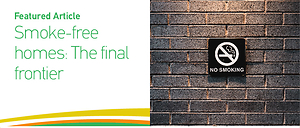Over 1.2 billion tobacco users worldwide and almost 8 million tobacco-related deaths make tobacco control a public health high priority1. While the number of smokers has fallen in high-income countries (HICs) in recent years, the number of tobacco users in many low- and middle-income countries (LMICs) has steadily increased2. In addition to active smoking, inhalation of secondhand smoke (SHS) is a major cause of premature death and disease, especially among women and children3,4. More than one-third of women5 and half of the children6 are exposed to SHS worldwide. The exposure to SHS during pregnancy is also high in many countries; the prevalence ranging from 6% in Nigeria to 73% in Armenia7.
The adverse health consequences of SHS exposure are well documented4,8-10. Exposure to SHS increases the risk of acquiring lower respiratory tract and middle-ear infections, invasive meningococcal disease, TB and incident cases, and recurrent episodes and increased severity of asthma among children10. Children living in smoking households are at risk of lower academic performance and a high rate of smoking uptake in later life11. SHS exposure during pregnancy can cause pregnancy complications, a modest reduction in birth weight, preterm delivery, stillbirths, and infant deaths10.
Level of SHS exposure at home
Private homes remain a major source of SHS exposure particularly for women and children. According to Global Adult Tobacco Surveys in Bangladesh, China, India and Indonesia, 36.5%11, 38%12, 39.3%13 and 75.4%14 of adult women are exposed to SHS at home, respectively. Globally, about 40% of children aged less than 14 years are also exposed to SHS within their homes15 and these estimates are much higher for LMICs in the South-East Asia, Western Pacific and Eastern Mediterranean regions. Studies that validated SHS exposure level using biomarkers have found even higher levels of SHS exposure among women and children3,16-18. In Bangladesh, 95% of school children in urban and peri-urban areas were found positive of recent SHS exposure18. There is, therefore, an urgent need to reduce exposure to SHS in women and children through implementing effective, affordable, inclusive, feasible and sustainable solutions.
Smoking restrictions at home
The WHO Framework Convention on Tobacco Control (FCTC) recommends that countries enforce comprehensive smoke-free laws as one of the effective demand-reduction tools (Article 8). However, comprehensive smoke-free legislation is only in place in 55 countries, covering just 20% of the world’s population19. Among LMICs, only 35 have adopted smoke-free legislation covering all categories of public places such as work sites, bars, restaurants, schools, universities, and healthcare institutions19. However, even the most comprehensive legislation would not address SHS exposure in households. Though some evidence suggests that smoke-free legislation has a positive effect on promoting smoke-free households20. Enforcing smokefree legislation remains weak in LMICs. Low-levels of voluntary restrictions on smoking in households and a high percentage of smokers, predominantly men, smoking in front of women and children are common in LMICs, especially in patriarchal societies. Although comprehensive smoke-free laws can protect non-smokers from SHS in public places and promote adoption of voluntary restrictions in homes, other measures are also required to protect people from SHS exposure at home. For women and children in particular, both smoke-free homes and smoke-free legislation in public places can ensure full protection.
Smoke-free home interventions
Creating awareness of the adverse consequences of SHS exposure3 and encouraging voluntary smoke-free rules in homes have been recommended to reduce SHS exposure among women and children and prevent SHS-related diseases and deaths. Clinical interventions delivered in antenatal care settings appear to reduce SHS exposure as pregnancy provides a window of opportunity for the entire family to change harmful behaviors. Schools, primary healthcare facilities and places of worship have been considered as acceptable settings to raise awareness, promote changes in smoking behaviors and reduce SHS exposure at homes4,8. The smokefree interventions delivered through school-based and antenatal care settings rely on motivation and ability of children and women, respectively, to persuade smokers to change their behavior. This is particularly challenging in countries where smoking is predominantly a male behavior; for example, in South-East Asia the male–female smoking ratio is 16:121. In such places, gender norms favoring male education, health and personal autonomy22, with the limited voice of women and children, make confronting smoking at home even more difficult. A number of systematic reviews also concluded that despite several studies on education and counselling programs, their effectiveness in reducing women and children tobacco smoke exposure were not clearly demonstrated17,23.
Reducing SHS exposure among women and children would require context-specific interventions that account for the differences in culture, social norms and smoking behaviors across countries4,8,24. Rigorous studies, using biochemical validation, are needed to identify the most suitable and relevant strategies for reducing SHS exposure in women and children. Further research is required to test comprehensive community-based interventions through community health workers, religious leaders and schoolteachers to influence smoking behaviors in their communities. A multisectoral approach and further investment are required to enforce smoke-free legislation and promote smoke-free homes. This will help achieve the goals set forth in the Sustainable Development Goals (SDGs) of reducing maternal mortality, preventing deaths of newborns and children, and reducing premature mortality from non- communicable diseases.


